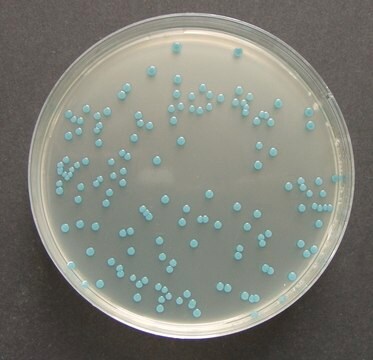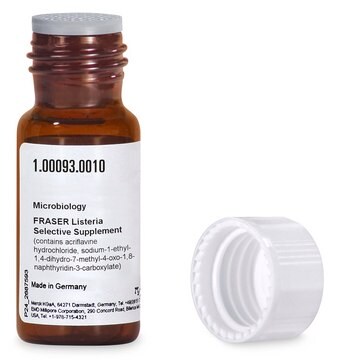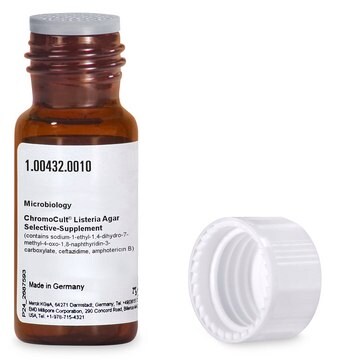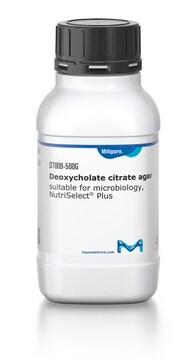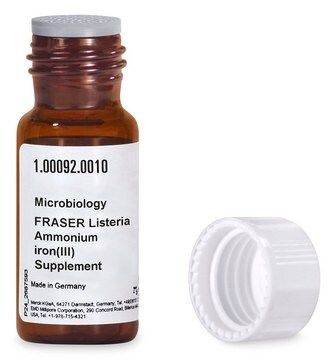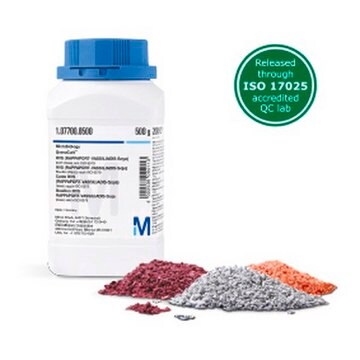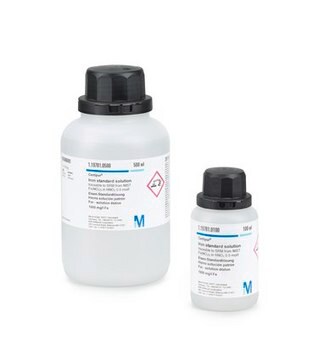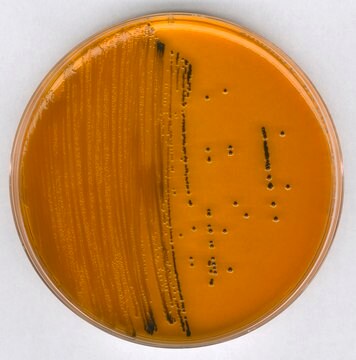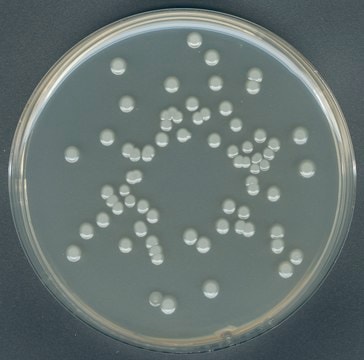1.02894
® plus agar z dezoksycholanem laktozy
for coliforms, suitable for microbiology
Synonim(y):
Agar selektywny dla bakterii z grupy coli
About This Item
Polecane produkty
sterylność
non-sterile
Poziom jakości
Formularz
granular
opakowanie
pkg of 500 g
producent / nazwa handlowa
GranuCult® plus
warunki przechowywania
dry media (Keep tightly closed)
metody
microbiological culture: suitable
kolor
red-brown
pH
6.9-7.3 (25 °C, 57 g/L in H2O)
rozpuszczalność
57 g/L
Zastosowanie
food and beverages
microbiology
temp. przechowywania
15-25°C
przydatność
coliforms
Powiązane kategorie
Opis ogólny
Zastosowanie
Cechy i korzyści
- GranuCult® oferuje najwyższej jakości granulowane pożywki hodowlane
- Bezpieczny i zrównoważony dzięki zmniejszonemu ryzyku związanemu z wdychaniem drobnego pyłu i substancji toksycznych, co skutkuje bezpieczniejszym środowiskiem pracy.
- Doskonała zwilżalność, rozpuszczalność i sypkość
- Wygodny, z minimalną separacją składników i zbrylaniem, nawet w ciepłych lub wilgotnych warunkach
- Wysoka powtarzalność między partiami
- Wydłużony okres trwałości do pięciu lat
- Duża liczba szczepów testowych przekraczająca wszystkie wymogi regulacyjne
- Technologia granulacji pozwala na dodanie wielu suplementów, bez konieczności dodawania ich oddzielnie
Komentarz do analizy
Wygląd (kolor): czerwono-brązowy
Wartość pH (25 °C): 6,9 - 7,3
Zachowanie podczas krzepnięcia (2 godz., 45 °C): płynny
Odzysk na podłożu testowym (Escherichia coli ATCC 25922 (WDCM 00013)): ≥ 40 %
Odzysk na podłożu testowym (Klebsiella pneumoniae ATCC 13883 (WDCM 00097)): ≥ 40 %
Odzysk na podłożu testowym (Enterobacter cloacae ATCC 13047 (WDCM 00083)): ≥ 40 %
Odzysk na podłożu testowym (Salmonella typhimurium ATCC 14028 (WDCM 00031)): ≥ 40 %
Odzysk na podłożu testowym (Salmonella enteritidis ATCC 13076 (WDCM 00030)): ≥ 40 %
Odzysk na podłożu testowym (Shigella flexneri ATCC 12022 (WDCM 00126)): ≥ 40 %
Odzysk na podłożu testowym (Proteus mirabilis ATCC 14273): ≥ 40 %
Odzysk na podłożu testowym (Enterococcus faecalis ATCC 11700): ≤ 0.01 %
Odzysk na podłożu testowym (Staphylococcus aureus ATCC 25923 (WDCM 00034)): ≤ 0.01 %
Kolor kolonii (Escherichia coli ATCC 25922 (WDCM 00013)): czerwony
Kolor kolonii (Klebsiella pneumoniae ATCC 13883 (WDCM 00097)): różowy/czerwony
Kolor kolonii (Enterobacter cloacae ATCC 13047 (WDCM 00083)): różowy/czerwony
Kolor kolonii (Salmonella typhimurium ATCC 14028 (WDCM 00031)): bezbarwny
Kolor kolonii (Salmonella enteritidis ATCC 13076 (WDCM 00030)): bezbarwny
Kolor kolonii (Shigella flexneri ATCC 12022 (WDCM 00126)): bezbarwny
Kolor kolonii (Proteus mirabilis ATCC 14273): bezbarwny
Osad (Escherichia coli ATCC 25922 (WDCM 00013)): +
Precypitat (Klebsiella pneumoniae ATCC 13883 (WDCM 00097)): +/słabe
Precypitat (Enterobacter cloacae ATCC 13047 (WDCM 00083)): +/słaby
Inkubacja: 24 godz.; 35 °C; tlenowa.
Inne uwagi
- Czerwone, otoczone strefą osadu: Laktoza-dodatnie: Escherichia coli
- Blade z różowym środkiem i otoczone strefą osadu: Słabo laktozo-dodatnie: Enterobacter, Klebsiella i inne
- Bezbarwny: Laktozo-ujemne: Salmonella, Shigella, Proteus, Pseudomonas i inne
Informacje prawne
Oświadczenie o zrzeczeniu się odpowiedzialności
Kod klasy składowania
11 - Combustible Solids
Klasa zagrożenia wodnego (WGK)
WGK 2
Certyfikaty analizy (CoA)
Poszukaj Certyfikaty analizy (CoA), wpisując numer partii/serii produktów. Numery serii i partii można znaleźć na etykiecie produktu po słowach „seria” lub „partia”.
Masz już ten produkt?
Dokumenty związane z niedawno zakupionymi produktami zostały zamieszczone w Bibliotece dokumentów.
Nasz zespół naukowców ma doświadczenie we wszystkich obszarach badań, w tym w naukach przyrodniczych, materiałoznawstwie, syntezie chemicznej, chromatografii, analityce i wielu innych dziedzinach.
Skontaktuj się z zespołem ds. pomocy technicznej